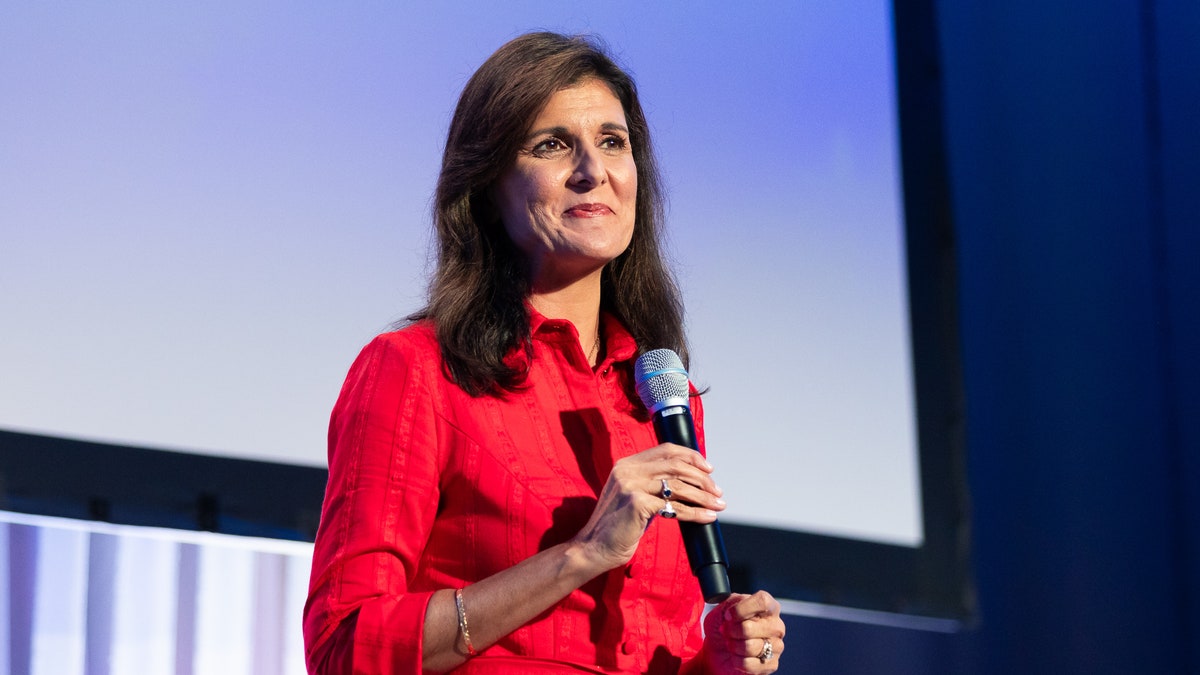A new poll from the Wall Street Journal shows Nikki Haley leading President Biden by 17 points in a head-to-head matchup.
Fifty-one percent of registered voters say they would support Haley if she was on the ballot against Biden, who takes 34%.
That lead is 13 points bigger than Trump’s lead against Biden (47% to 43%), while Gov. Ron DeSantis appears tied with the incumbent president (45% each).
The survey comes as Haley ties her closest rival, Ron DeSantis, in multiple primary polls. The former South Carolina governor is hoping strong finishes in Iowa and New Hampshire — where Gov. Chris Sununu offered an endorsement to Haley last night — will give her enough delegates to surpass DeSantis and make a race of it with Trump.
Still, there’s more to the equation than this poll.
Haley’s strength relies on her apparent appeal to more moderate voters than Trump. At the same time, there’s a question of whether she will get the kind of strong GOP turnout that carried Trump to victory in 2016. Indeed, whether Haley is the strongest Republican candidate depends on three numbers:
1. How many moderates, independents and crossover voters would Haley win?
The Journal’s poll is the latest to show Haley with a lead in a general election matchup with Biden.
CNN/SSRS found in a late October survey that Haley leads Biden by six points, 49% to 43%.
Days later, Marquette tested the matchup and had Haley at 41% to Biden’s 38%.
When Marquette included voters who said they were leaning toward either candidate, Haley took a 10-point lead and a clear majority, with 55% support versus Biden’s 45%.
The Fox News Poll provides insight into both her overall level of support and her performance with moderates, independents and crossover voters.
According to the mid-November survey, Haley has an 11-point lead and a majority in a matchup with the incumbent president. The former governor takes 52%, with Biden trailing at 41%. The support that gets her over that line comes from, among others:
Moderates, who prefer Biden over Trump by five points (49% to 44%), back Haley over Biden by 12 points (51% to 39%). Independents, who prefer Trump over Biden by 16 points (52% to 36%) and back Haley over Biden by 43 points (65% to 22%).Moderates and independents do not, on their own, make or break a candidacy. But they are a critical voting bloc in a general election, and Haley is posting very strong margins with both.
There’s even better news for Haley with crossover voters.
Among people who voted for Biden last cycle, 90% say they would stick with the incumbent in a rematch against Trump.
If Haley is the candidate, 81% of Biden 2020 voters say they would stay put, but 14% say they would switch to the South Carolina governor.
In a highly polarized political environment, that’s a notable advantage.
The 2024 general election is about a year away, so this is as good a time as any to remind voters that polls are a snapshot of the current electorate, not a prediction of the outcome. If Haley is the nominee, Democrats will seek to polarize voters and depress Republican turnout.
For now, Haley has an undeniable advantage with moderate, independent and crossover voters.
Looking ahead: Haley and the debates
Haley has at least one major advantage over Biden when looking at her general election campaign.
Polls consistently show that age is a serious vulnerability for President Biden.
The last weeks of the campaign will test his cognitive abilities more than any other time because he will likely (but not definitely) participate in three general election debates.
Those debates remain an extraordinary opportunity to speak to a wide audience. Seventy-three million Americans tuned into the first general election debate in the last cycle.
By virtue of her age advantage alone, Haley would be a formidable competitor.
That advantage looks even bigger when you consider that Haley’s rise in the primary field tracks alongside her performance at the first three Republican debates. Her tangles with rival Vivek Ramaswamy became standout moments.
2. How many Trump voters would turn out for Haley?
So far, in a general election matchup, polls show Haley holding on to a similar share and types of voters as those who chose Trump in 2016 and 2020.
Returning to the latest Fox News survey: 94% of Trump voters in 2020 say they would support Trump again now in a matchup with Joe Biden, and 89% say they would support Haley against Biden.
(With a margin of error of plus or minus 4.5 points for 2020 Trump voters, that five-point gap between Trump and Haley isn’t large enough to read into.)
There are substantive policy differences between the two candidates that affect these groups, and there are also the political realities of defeating Trump in the primary. Both could complicate Haley’s pathway in a general election.
Haley’s policy differences with Trump
First, remember that an important element of Trump’s victory in 2016 was increasing Republican turnout by bringing new types of voters into his coalition. Some previously voted for Democrats, but a surprisingly high number were new or reactivated voters.
For example, an analysis by the Center for American Progress found that in both Michigan and Pennsylvania, the increase in turnout among White non-college-educated voters alone was enough for Trump to defeat Hillary Clinton.
That group and three others – White rural, White evangelical and White working-class voters, all of which have significant overlap — helped give Trump his upset win.
Overall, Republican turnout has hit record highs throughout the Trump era of conservative politics.
Today, Haley’s margins among a sample of registered voters are strong among these groups. From the Fox survey:
White voters without degrees prefer Trump over Biden by 20 points (58% to 38%) and prefer Haley over Biden by 23 points (58% to 35%). White rural voters prefer Trump over Biden by 27 points (62% to 35%) and prefer Haley over Biden by 37 points (66% to 29%). White evangelical voters prefer Trump over Biden by 51 points (74% to 23%) and prefer Haley over Biden by 32 points (71% to 39%).Haley’s position on topics like inflation, immigration and crime, which are all strong turnout motivators, mean she would likely receive a significant share of Trump 2016 and 2020 voters.
But there are also warning signs that these voters, some of whom can also be the most difficult to engage, could be less enthusiastic in the general election about a Haley candidacy.
Consider foreign policy. Haley told Fox’s Neil Cavuto in July that Ukraine should be admitted to NATO and has criticized Biden for failing to adequately respond to the war. Trump says he would end it immediately, which would inevitably give Russia at least some of Ukraine’s territory.
Trump coalition voters, though, are among the least likely to support ‘doing more’ to help Ukraine.
Overall, 18% of non-college educated White voters, 18% of rural Whites and 20% of White evangelicals agree with doing more to help Ukraine. (Remember, about a quarter to a third of the voters in these groups are Biden supporters). Just 13% of the GOP supports the same.
These are some of the lowest numbers across all demographics in the survey.
These groups also support keeping benefits over reducing the deficit more than all voters and have lower levels of trust in government institutions.
The impact of a Trump loss in the Republican primary
This analysis is based on two possibilities. That is, either Trump or Haley is the GOP candidate on the general election ticket.
In reality, though, Trump has a much clearer path to becoming the Republican candidate for president than Haley does. He polls at 59% nationally and notched a 51% majority in the latest Des Moines Register/NBC News poll out of Iowa.
So, what would it look like if Trump lost the Republican nomination?
For one thing, polls out today show that Trump voters are enthusiastic about their candidate. The same Iowa survey shows that 70% of them have already made up their minds about supporting him, and 45% are ‘extremely enthusiastic’ about that choice. That’s more than double Haley or Ron DeSantis in each case.
In a scenario where Haley gains so much momentum in the early primary states that it’s enough to topple Trump on Super Tuesday and beyond, you have to consider how Trump would react to that loss.
History suggests he will not be a Haley surrogate.
Trump has steadfastly refused to sign the Republican Party’s ‘loyalty pledges’ designed to ensure that candidates would back any GOP presidential nominee, even forcing a rule change in Florida to get on the ballot.
Trump also reportedly told RNC Chair Ronna McDaniel on the last day of his presidency he was ‘done’ with the party, adding, ‘You lose forever without me. I don’t care.’
How Trump would undermine a Haley candidacy in the general is a subject for speculation, but there is a high likelihood that he will.
3. How many Democrats would turn out for Biden with Haley on the ticket?
So far, we’ve established that Haley polls well with moderates and independents, but there are reasons to question whether Trump voters would show up if Haley is on the ticket next November.
There is one more piece to this puzzle.
If Haley appears on the ballot, it could also impact the number of Democrats who turn out for President Biden.
(Biden needs to be nominated first, but as an incumbent president with little primary competition, the most likely scenario where he doesn’t become the nominee is one where he chooses to step down.)
As above, Trump’s victory in 2016 was thanks in part to increased turnout among untraditional Republican groups.
The most important factor in his victory, though, was low Democratic enthusiasm for Hillary Clinton.
Democrats learned from their bitter loss in 2016 and turned out in much higher numbers four years later, delivering Biden his first term in office.
And just as Trump squeezed more votes out of key voting groups in that election and throughout his political career, so too have the Democrats. More suburban, Black, and youth voters are showing up, and they’re delivering Democratic wins.
Three years later, the Democrats now have two major turnout motivators — threats to democracy and abortion. Haley would go some way in neutralizing the first issue and less so the second.
Haley and threats to democracy
Democrats mobilized midterm voters by talking about Trump’s attempts to overturn the 2020 presidential election and the Jan. 6 riot.
In that election, according to the Fox News Voter Analysis, 44% of voters identified ‘the future of democracy in this country’ as the single most important factor in their decision to vote, and 60% of those voters were Democrats.
The presidential electorate is expressing similar views. According to a November CNN/SSRS survey, 87% of Democrats call voting rights and election integrity ‘extremely’ or ‘very important’ to their vote for president, tied with the economy as the No. 1 issue on those voters’ minds.
A Haley nomination could impact those ratings.
First, the governor said she would accept the results of the 2024 election, a commitment Trump famously never made.
Haley has also been willing to criticize Trump for his post-election efforts, telling a crowd of Republicans the day after the Jan 6 attack, ‘His actions since Election Day will be judged harshly by history.’
And in a debate hosted by Fox News in August, she backed former Vice President Mike Pence’s decision to certify the presidential election results in 2021, saying, ‘I do think that [he] did the right thing, and I do think that we need to give him credit for that.’
This makes it tougher for the Biden campaign to tie Haley to ‘MAGA extremism,’ an attack it has deployed against Trump-aligned candidates since 2021.
Haley and abortion
Abortion was also a critical part of Democrats’ performance in 2022.
Again, from the Fox News Voter Analysis: 25% of voters said the Supreme Court’s decision to overturn Roe v Wade, the 1973 decision on abortion, was the single most important factor in their decision to vote, and 71% of those voters were Democrats.
Today, 80% of Democratic voters call it an extremely or very important issue when it comes to their vote for president, per the CNN survey.
Haley has tried to stake out a more moderate position on the issue. She said at the start of her campaign that the next president needed to ‘find national consensus’ on the issue in a speech she delivered to Susan B. Anthony Pro-Life America’s office.
The governor also publicly disagreed with a Texas court decision to suspend FDA approval of the abortion pill mifepristone and said at the first debate that contraception should be available.
Even so, Democrats have opportunities to fire up their base with Haley’s positions.
As governor, Haley signed a 20-week abortion ban into law and made headlines last month when she said she would have signed a six-week ban if it had passed through the state legislature.
At the federal level, Haley cites the Senate math, saying it makes some bans ‘not realistic.’ But she also told Shannon Bream on Fox News Sunday that ‘whatever 60 Senate votes comes to, whether that’s 15 weeks, I absolutely would sign it.’
And in the same Susan B. Anthony speech, Haley made it clear ‘there is a federal role on abortion,’ a comment vague enough to make its way into an attack ad come 2024.
Haley’s strength among moderate and independent voters is an encouraging sign for her supporters and may help her make inroads with pragmatic primary voters.
A full examination of her campaign should involve a discussion about turnout as well.
There are reasons to believe Trump’s base — and the former president himself — could depress overall GOP turnout in a Biden-Haley matchup. There are also signals that Democratic turnout would be lower too.
Voters are a month away from finding out just how likely that matchup is.























